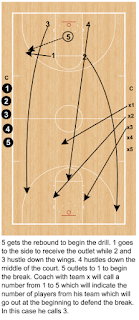1 V 1 Squaring Up Your Opponent
One of the most difficult things to teach young players is also one of the most important in determining how good a 1v1 player your going to be. The move in question is what I like to call "Squaring up your opponent." What this means is that when you receive the ball in a position to score, the first thing you do is turn and face the basket in a triple threat position. At a young age this move is instinctively difficult because young players feel that they are not protecting the ball when facing the basket. Their natural instinct is to turn their back to the basket so they can protect the ball. What this does is it prevents the player from surveying the floor and/or breaking down his player. Another move for kids this age is that they may turn and face the basket but they forget completely about protecting the ball. This is one of the reasons you see a lot of jump balls in youth games in addition to seeing many balls being ripped out of the hands of players by the opposition. With this post what we want to describe is the proper way for a player to square up the opponent while protecting the ball.
There are 3 items that we need to discuss when talking about the square up:
As you can see the pivot is so important to basketball. What separates the great players from the rest of the bunch is their footwork. The best can pivot easily off either foot. Remember to practice this whole sequence because this is the first part of successful offensive basketball. If you cannot square up your opponent on offense you stand very little chance of succeeding. This is truly one of the keys to offensive success.
There are 3 items that we need to discuss when talking about the square up:
- Jump stop to receive the ball - players need to get comfortable with the jump stop. When receiving a pass the jump stop is a great way to allow you to use either leg to pivot off of. If you catch a pass with one leg on the ground then that leg will be your established pivot foot. This will not be the case with a jump stop as you will catch the ball with both feet on the ground and thus give yourself an option as to which foot you can pivot off of.
- Pivots to enter square up position - players need to be comfortable receiving the ball and then doing a pivot into the triple threat position. There are 2 types of pivots. The first is the forward pivot in which the player will pivot in the direction of his pivot foot (ie. left foot on the ground, pivot to the left). This pivot is good when you want to move away from the player covering you. The second pivot is called the reverse pivot and it involves having the player move in the opposite direction of his pivot foot (ie. left foot on the ground, pivot to the right). This pivot is a great way to create space between you and your defender and should be used when entering the triple threat stance. The video below explains the difference between the two pivots.
- Triple threat position - Once you have pivoted and are facing the basket then you enter your triple threat position. The one thing you need to be aware of is that the triple threat position is not a static position. You can't just sit there in one place once your in triple threat. Triple threat is a fluid position which requires that the player with the ball uses rips of all kinds in addition to pivots to continue keeping the player guarding him off balance. The video shows all three of the points in action:
As you can see the pivot is so important to basketball. What separates the great players from the rest of the bunch is their footwork. The best can pivot easily off either foot. Remember to practice this whole sequence because this is the first part of successful offensive basketball. If you cannot square up your opponent on offense you stand very little chance of succeeding. This is truly one of the keys to offensive success.



Comments
Post a Comment